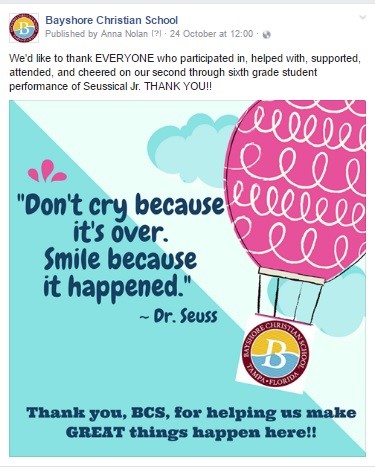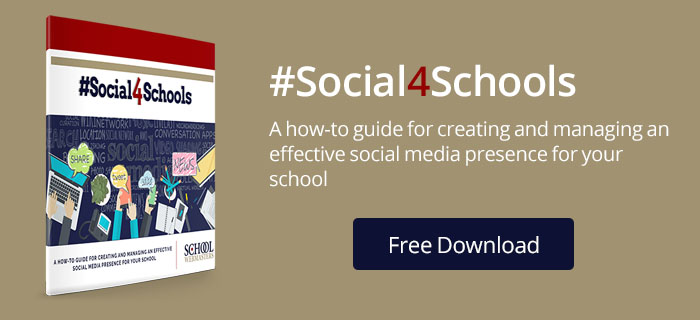So, you’ve finally seen the light and made social media a part of your school’s communication strategy. Congratulations! You’ve seen the studies showing you the number of people using social media on a day-to-day basis for much more than just keeping up with family and friends; they’re using it to help with important decisions, like choosing a school for their kids, for example. You’ve read the blogs, downloaded the e-books (right?), and watched the DIY videos for setting up school social pages (we hope!). Your school social media pages are up and running. So now what?
Class is in Session
Because we offer a complete line of school social media management services, we spend a lot of time learning about the latest and greatest for building engaging posts on the social media platforms schools use most. We’re happy to share some of the basics with administrators who have the time and inclination to take on a quick study in Social Media Management 101. In fact, we’re so excited about helping do-it-yourselfers, that we have enough material for this to be the first part in a two-part series. So read on to learn more about post frequency, timing, and why it matters. We’ll also introduce some of the elements that make up an engaging social media post; just enough to whet your appetite for part two in our little self-help course.
The Evolution of School Social Media
If you’ve decided to manage your school social pages internally, your work has just begun. Just being on social media isn’t enough, but hopefully you already know that. We’ll take that a step even further by saying that just posting to your social media pages isn’t quite enough. Not anymore. As social media has grown to one of the most widely used forms of communication (next to texting), the standards for what it means to effectively communicate via social platforms have evolved. Today, when you want to spread the word about your school’s annual fundraiser, it takes more than just typing out a post with the name and date of the event for Facebook and Twitter. Creating a social post that your followers will actually stop and read vs. just scroll past on their news feed requires a bit more pizzazz. Sound scary? Never fear! We’ve broken down some of the most effective ways to spruce up your social posts and grab your audience’s attention. Is it time-consuming? Well, yes (scroll down to learn about hiring professionals to take this important task off your plate). Is it worth it? Absolutely.
Quantity: How often to post and when
Think back to your high school chemistry class when you studied the half-life of radioactive atoms. Ringing a bell? Believe it or not, social media posts have a half-life, too. Put simply, the half-life of your social post is the point in time when you can expect it to fall to half its initial value. After a certain amount of time passes from the time you first publish your post, you can expect engagement to go down (likes, shares, comments, etc.). A social media post’s half-life varies with each platform, and understanding how long your post will actually stay in front of your audience is key to knowing how often you should be updating your social pages. Not only that, it stresses the importance of your post being constructed in the most effective way possible, using the most effective tools.
Though the half-life of social posts will usually depend on your audience and demographics, many studies agree on some average numbers for popular platforms:
- Facebook: About 2–3 hours
- Twitter: 15–20 minutes (no surprise, since Twitter’s model is based around sharing short, sweet thoughts).
- Pinterest: 2 days (remember, Pinterest is based on shares, so clicks can keep coming for as long as 30 days after the initial pin).
- YouTube: About 7 hours
- Instagram: About 2 hours
- Snapchat Stories: Standard snaps disappear after 10 seconds. Snapchat Stories stay visible for 24 hours, but like Twitter, will only really stay on your followers’ radar for about 15–20 minutes.*
*The Snapchat app is quite popular among teens, but its usefulness/appropriateness for schools is subject to some debate. To learn more about it, try some recommended reading:
- U.S. News: High Schools Experiment with Snapchat to Reach Teens
- Common Sense Education: Snapchat Review
- Ditch That Textbook: Snapchat 101 for Teachers—What you need to know
So how does this apply to you, the school administrator? Are we really advising you to post to FB every two hours and tweet every 20 minutes? Of course not. You’re educators and we’re realists. Not only is it impractical to try and schedule this many social posts per day, it will likely do nothing more than annoy your followers. The takeaway here is to realize how important it is to post regularly, keeping up with the general flow of information being disseminated on the social platforms you’re using. With that in mind, here’s the post frequency we recommend school’s follow:
- Facebook: Every weekday. You can throw in weekends if you really want to stay in front of your audience but, let’s face it, parents aren’t usually expecting to hear from their kids’ schools on weekends.
- Twitter: 2–3 times per day
- Pinterest: 10–15 new pins per week
- YouTube: Add a new video as often as you create one to keep your school’s YouTube channel updated.
- Instagram: 1 photo per day (more if you have a particular event going on).
- Snapchat: If you choose to use it, adding 1 snap every day will keep you on your community’s radar.
Timing is (almost) everything
Now that you know how often to post, it’s important that you also determine the best time to post. Each social media platform you use has an analytics tool that can help you study when your followers have been most likely to interact with your posts. Simply performing your own study can give you the tailored information you need to schedule posts at the best times for your community. We can, however, take a little bit of the guesswork out of it for you by sharing recent studies. Hootsuite, one of our favorite social media management resources, recently compiled the results of several different analyses in their article, “The Best Time to Post on Facebook, Twitter, and Instagram in 2016.” You’ll find some overlap in the results, but most studies seem to agree that your followers are more likely to engage with your social media posts late in the afternoon to early evening. There are some studies that show the effectiveness of early morning posts as well. It makes sense. Basically, think about when people are checking their phones. While we all take an occasional peek at our social pages while we’re supposed to be working or paying attention at school, most people are consistently checking in before they begin their day or after school/work. If your tweets have a half-life of only 20 minutes, be sure you’re posting when your audience is actually looking.
Quality: Well-constructed posts matter
Posting regularly with the demands of your community and the platform you’re using in mind is important. Even more important, though, is the quality of your posts. Even if you’re posting a single sentence with no visual content (photos, videos, etc.) every day, studies show you’re still going to get less engagement than a school that builds posts with current social media trends in mind—even if they’re posting a little less often than you. It’s the difference between the energy you feel from a post that looks like this:

And one that looks like this:

Which one is more likely to get your attention? Like it or not, today’s average social media user has a short attention span and is attracted by shiny objects. Social media feeds us information, but it’s mostly considered a form of entertainment. Schools cannot afford to deny the type of competition that idea introduces. Your followers are not on FB to read lines and lines of plain text; they’re there to experience the personality of the people and pages they follow. They want you to do more than tell them why your school is the best; they want you to show them. So show them! Today’s successful social media posts, the ones that invite the most likes, shares, retweets, and link clicks, usually include at least one of these elements:
- Themes & Hashtags
- Photos & Videos
- Graphics & Gifs (legal ones!)
- Campaigns/Contests
- Cross Posting
To Be Continued…
There’s too much to say about using the above elements to their full potential, and we can’t resist a little anticipation. In part two of this series, you’ll learn more about creating engaging social media posts that meet today’s industry standards, which is important if you’re going to keep up in the fast-paced world of online communications. Stay tuned!
Social Media Management 101, Part 2
P.S.
If you’ve gotten this far and have already decided that it makes more sense to hire professionals with the right skill sets to manage your district or school’s social media presence (more on that later), we invite you to learn more about our social media services. We hope you’ll consider partnering with us!

Anna Nolan, Social Media Director








